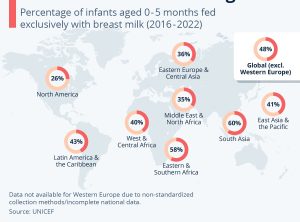In a press release published ahead of World Breastfeeding Week (August 1 to 7), the World Health Organization (WHO) reports that: “Over the past 12 years, the number of infants under six months who are exclusively breastfed increased by more than 10 percent globally.” Now, almost half (48 percent) of infants worldwide benefit from this ‘excellent start in life.’
But this progress remains to be put into perspective if we take into account sales of breast milk substitutes, which have more than doubled worldwide over the last 20 years. Additionally, while countless studies have found the benefits of breastfeeding, others have claimed that when you eliminate selection bias, i.e. richer women being more likely to breastfeed, the positive effects almost disappear as larger socioeconomic factors overlay the still substantial benefits that breast milk does have.
Breastfeeding is sure to providing all the nutrients and energy needed for the growth and development of newborns and provides immune protection and other benefits through bioactive ingredients that formula doesn’t have.
In developing countries, water safety is another factor that makes breast milk the superior option, while of course, the small chance of formula itself being contaminated also remains a risk. However, the product is still marketed aggressively around the world, using with exaggerated claims to its benefits – something that has been criticized widely together with the baby milk industry’s high spending on lobbying.
 The WHO recommends exclusive breastfeeding until the age of six months and continued breastfeeding (with appropriate complementary feeding) until two years or more. However, apart from the response to marketing, not exclusively breastfeeding can have many reasons, including the mother working, personal reference, division of labour considerations and physical issues breastfeeding.
The WHO recommends exclusive breastfeeding until the age of six months and continued breastfeeding (with appropriate complementary feeding) until two years or more. However, apart from the response to marketing, not exclusively breastfeeding can have many reasons, including the mother working, personal reference, division of labour considerations and physical issues breastfeeding.
As our map based on UNICEF data shows, the regions where breastfeeding is most prevalent are South Asia and Eastern and Southern Africa, where around 60 percent of infants aged zero to five months are exclusively breastfed.
Conversely, breastfeeding rates up to six months are lowest in North America (26 percent) and Eastern Europe and Central Asia (36 percent).
For Western Europe, this data is not available due to the lack of a standardized collection method and incomplete national data, but breastfeeding rates are generally low across Europe.
Buchholz writes for Statista


